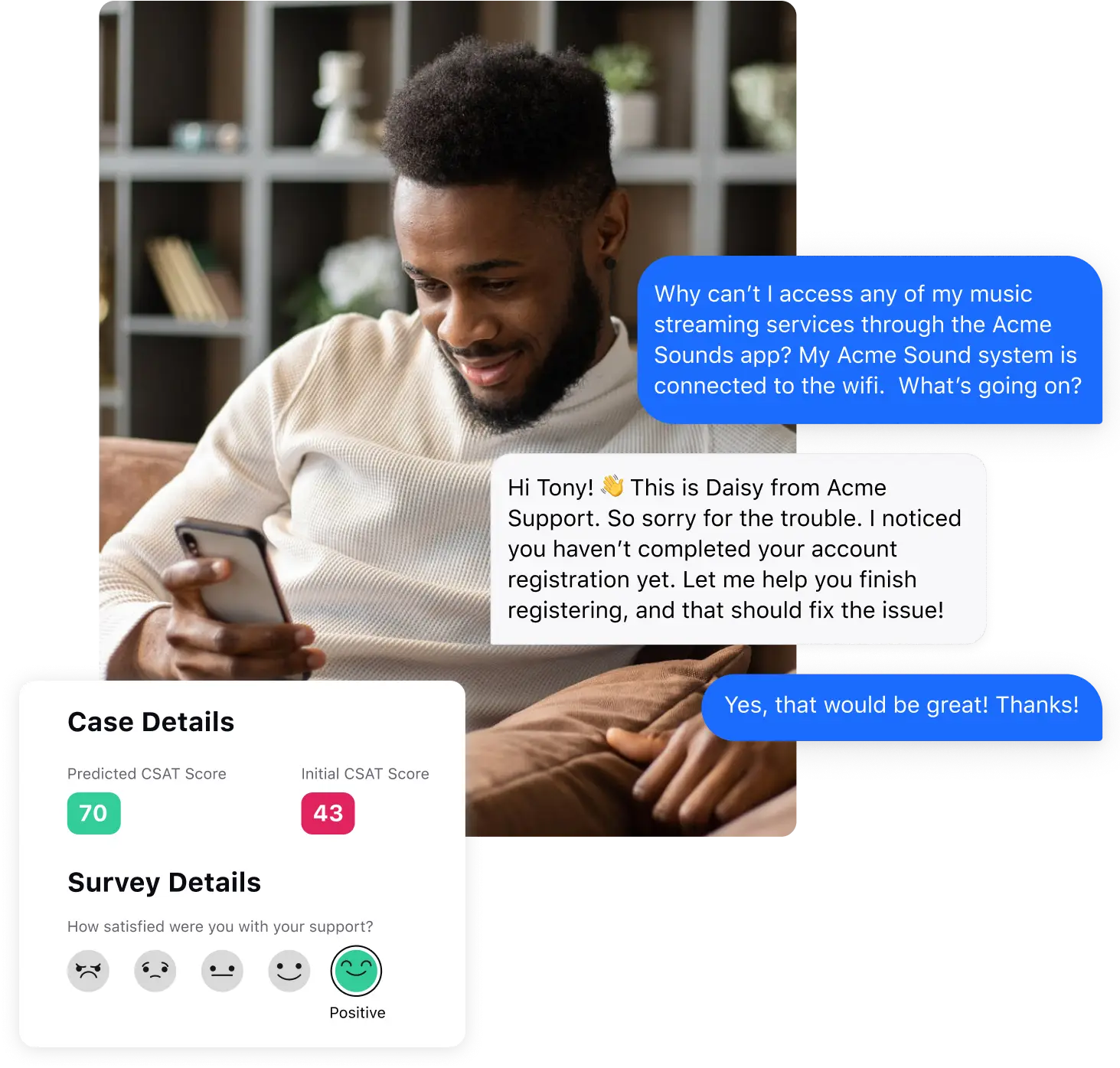The next generation of CCaaS is here
Digital-first customer service, enterprise-scale voice support. Redefine customer service with an AI-powered platform that unifies voice, digital and social channels. Power channel-less interactions and seamless resolution no matter the channel of contact.

5 social media customer service metrics to track in 2023
We are no more in an age when social media used to be a tiny part of your brand universe. Today it is an extension of your brand where you assess how your marketing efforts to woo customers are materializing in the real world. And going by this shift, you are doing everything possible to respond to your customers, interact with them, solve their problems and follow trends to keep them hooked. Sure, you earned a lot of followers and fans in this process, but have you kept track of how well your social media strategy is performing with respect to your competitors? Or, how much extra money do you have to put into socials to ensure your customers have exactly what they need on their feeds? How well are you handling customers' needs on social media? How many people are getting in touch with you? The answers to these questions will come to you only when you start measuring your social media efforts with the right social media metrics. Before that, let’s dive deeper into what social media customer service is.
What is social media customer service?
Social media customer service is a structured way of reaching out to customers and providing superior customer support across social media platforms. The social media customer service strategy covers support and services pre-purchase, during, and post-purchase journey of a customer. The key goals of social media care are to address complaints, provide guidance, answer complicated questions, and redirect to relevant authorities for help. In short, if done right, customer service through social media can allow your brand to retain existing customers and woo prospects.
Why do you require social media customer service?
A recent Harvard Business Review Analytic Services study revealed that brands successful in integrating social media and customer experience could provide experiences for their customers that can even outperform their competition. These stats corroborate the impact of social media on customer experience and how you can create differentiation in your respective markets. Leveraged in the right way, social media customer support can be both an insight pool for unveiling pain points across customer journeys and a medium for targeting the right customers at the right time. But do you go about it? Let’s understand a few social media customer service best practices.

Social media customer service best practices
There’s no denying that social media is widespread with opinions, negative remarks, and feedback, as people are free to speak their minds. Social media allows brands to delve deeper into customers’ lives and understand how exactly they are feeling. Hence, it is important to provide a best in class customer service on social media. Here are some key social media customer service best practices:
a) Know your audience well
The very first step before you provide customer service on social media is to know your audience well. You can begin by going after demographics and the real personas behind social media. For example, you should be aware of:
- Which influencers do they follow on social media
- What are their preferences, and how are they using social media
- Do they have a habit of complaining on social media
- What kind of content do they share on social media
In parallel, you should also pay attention to social media conversations and turn them into critical customer insights to ace up your support and targeting tactics.
b) Never miss out on feedback
Customers are very vocal about their feelings these days. They take every opportunity to exhibit their concerns or even likeness related to customer support or any new product in the market. The most effective way to put their thoughts into action is to collate feedback from all sources and channels. You start collecting feedback on social media by:
- Directly conversing with customers by engaging in comments, shares, or DMs
- Asking your customers to take part in polls and providing them with hampers for participation
- Generating online surveys and enticing different users to participate with the help of discount codes and shopping vouchers.
- Implementing social media listening tools to monitor all kinds of online conversations that have direct and indirect mentions of your brand
These insights from customers’ feedback can give you a complete picture of their problems and allow you to provide appropriate solutions.
c) Engage, engage and engage
Ideally, every brand wants to leverage opportunities to engage with customers at every touch point. However, only a few are able to do it. The most crucial step is to cut down social media customer service response time, regardless of platform or channel. And then, gradually implement social media customer service tools so you can engage with customers actively no matter the social media customer service platform you are using.
Now that you have understood the importance of social media customer service, let's find out how other companies are measuring the effectiveness of customer service through social media.
Here are five key social media metrics you should be thinking about right now if you want to understand what your customers feel about you.
1. Social media SLA compliance
An SLA (service-level agreement) is a core method of measuring how quickly a company handles a customer inquiry. To track social customer care performance via an SLA, a company will set a goal such as responding to all tweets and Facebook messages within two hours.
If all such inquiries receive responses in two hours or less, then the company’s SLA is 100%.
Some companies take SLA compliance to the next level by setting goals for how long it takes to actually fix a customer issue. Social media SLA metrics can be used to track individual team members or an entire department. SLA is useful for holding employees responsible for the level of customer care they provide. Having such a specific goal sets a very clear standard that, when met, ensures a satisfactory response time to customer concerns.
2. Customer Satisfaction Score
Another one of the most basic—and important—methods of assessing a company’s social media customer service is the customer satisfaction score. After a customer’s issue is resolved via social media, he or she is asked to rate the interaction on a scale of 1-5 (1 being “poor,” 3 “neutral” and 5 “satisfied”).
Paying close attention to customer satisfaction scores is a simple and effective way to gauge how well a customer care department is working. Companies can track their average scores on a monthly basis, assist customers who have given low scores, isolate larger trends, and identify best practices that may ultimately improve their standing in the eyes of customers.
It’s one thing to be prompt and responsive to customer concerns, and it’s another to tackle these issues in a strategic way. The customer satisfaction score provides the insight necessary to do just that.

3. Net Promoter Score
According to Nielsen, recommendations from friends and family is the most credible form of advertising. Considering the amount of information that consumers see from their friends on social media, it is critical for companies to treat customers with a level of care that turns them into advocates.
The Net Promoter Score (NPS) is a bit more nuanced than the customer satisfaction score. To establish the NPS, a company will ask a customer how likely — on a scale of 1-10 — they are to recommend the company to somebody else.
As with customer satisfaction scores, companies are turning to social media — X, formerly Twitter, especially — to conduct NPS surveys.
Some companies send timely questions to customers after they’ve purchased their product and then again when they’ve purchased another product. This approach allows for a steady cadence of feedback about the customer experience as companies can track how customer happiness changes over time.
Regardless of when and how often an NPS query goes out, the scale it uses is more or less the same across the board. A respondent who gives a ranking of 0-6 is considered a “detractor,” a respondent who gives a 7 or 8 is considered “passive,” and a customer who gives a 9 or 10 is considered a “promoter.”

4. Call Deflection
Social platforms that anticipate and solve customer issues can be extremely beneficial to a company’s bottom line. Experts have determined that a call center interaction can cost a company up to $12, while a social interaction costs less than a dollar.
Companies can keep track of call/issue deflection, which is generally determined by measuring website traffic versus the number of calls received. This ratio helps show how many customer issues are diffused by content on a company’s website and, more importantly, social media channels.
Social allows for more precise measurements. Companies can gauge call deflection by tracking how often customers use social care tools versus how often they call or email. Brands measure how many likes, replies, and messages they receive, compared to how many customer care inquiries come in via phone calls and emails. Armed with this information, companies can optimize their customer care capabilities so that the most popular outlets have the proper resources.
5. Inbound Volume
A fundamental way of tracking social customer service is to keep count of their inbound volume. Translated it means, a vast amount of support-related social mentions that a company receives in an hour or day. Tracking inbound volume offers a straightforward way to keep tabs on its customer care capabilities and determine how consumers react to certain products. By tracking how many customers interact on social media around customer care issues, a brand can become more attuned to what people are saying about them. It’s a critical element but oftentimes overlooked consideration when it comes to customer care.
Final thoughts
With social emerging as the de facto way for customers to communicate with brands — and vice versa — it’s imperative for companies to measure their customer care efforts with these five reliable metrics. There may be a few additional metrics that complement your brand’s unique social customer care goals, but the five listed above will provide any brand with the insights it needs to ensure the best possible social customer service.



